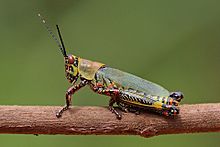Zonocerus variegatus
| Zonocerus variegatus | |
|---|---|

| |
| Scientific classification | |
| Domain: | Eukaryota |
| Kingdom: | Animalia |
| Phylum: | Arthropoda |
| Class: | Insecta |
| Order: | Orthoptera |
| Suborder: | Caelifera |
| Family: | Pyrgomorphidae |
| Genus: | Zonocerus |
| Species: | Z. variegatus
|
| Binomial name | |
| Zonocerus variegatus (Linnaeus, 1758)
| |
Zonocerus variegatus, the painted grasshopper or variegated grasshopper,[1] is a species of insect belonging to the family Pyrgomorphidae. It is native to tropical Africa,[2] and is considered a crop pest in much of Western and Central Africa.
Description
The adult grasshopper is extremely colourful, having large red compound eyes, a boldly patterned black, white, red and yellow body and legs, and greenish membranous wings. The nymphs also have red eyes, but lack wings and are black, with yellow and white markings.[1]
Distribution and habitat
Zonocerus variegatus is native to tropical West and Central Africa. It is an important agricultural pest in Ghana, Togo, Ivory Coast, Nigeria, Congo Brazzaville, Southern Benin, and the
Ecology

Both nymphs and mature Zonocerus variegatus cause damage to crops, particularly
Uses
There is a long tradition in Africa and Asia of eating insects, and these provide a high quality source of animal protein, nutritionally superior to beef and chicken. Grasshoppers are the most widely eaten insect and Zonocerus variegatus is a common species that has been eaten traditionally for centuries. In the dry season in northern Nigeria, the grasshoppers are gathered from grasses and bushes before dawn, when the insects are quiescent. They are then de-winged, salted and fried.[5]
The insects contain about 10% chitin, the derivatives of which are of interest in medical research, in industry and agriculture, for the manufacture of biodegradable plastics, in wound repair, as a crop booster, and as a nematicide and fungicide.[5]
References
- ^ a b Jonathan Cleverly. "Zonocerus variegatus". Jonathan's Jungle Roadshow. Retrieved 24 February 2021.
- ^ a b "Zonocerus variegatus (Linnaeus, 1758)". www.gbif.org. Retrieved 31 January 2021.
- ^ "Zonocerus variegatus (variegated grasshopper)". Invasive Species Compendium. CABI. Retrieved 23 February 2021.
- PMID 16573815.
- ^ ISSN 2141-422X.
